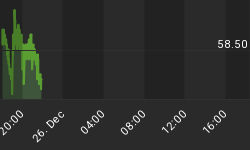The past two weeks were unprecedented in the size of monetary expansion around the world. World financial authorities have finally realized that the economy is on the edge of a deflationary spiral as in the following diagram:

The result of the spiral may well be a world economic depression.
Despite a steady progression by the central banks to zero percent interest rates and a quantitative easing policy, the reaction of most world markets was either muted or negative. Continually falling prices on energy, base metals and other commodities indicate that deflationary forces prevail, at least for now.

While there are many reasons for deflation, we will list the ones that are most important in our opinion:
-
Main efforts by the Fed have, up to now, been directed toward systemic risk. Huge increases in the Fed's balance sheet have not led to a reflationary effect, since the Fed is still using a "sterilization" mechanism.
Most of these so-called bailout programs have been made by providing "bridge loans" to banks and other financial institutions. These loans are not given in cash, but rather in special short term Fed bills in exchange for collateral (bad assets). While these funds strengthen the balance sheet, they cannot be used to give out further loans (i.e. they are restricted for commercial lending). Therefore, these bridge loans do not lead to new money creation but only to toxic securities sterilization.
-
Despite the Fed's attempts to improve the balance sheets of the banks, raising capital from the private sector by financial institutions remains extremely difficult. Moreover, steep contraction in commercial credit continues, banks are tightening lending standards and are hoarding money. As a result, bank excess reserves with the Fed have grown from just about zero to $600 billion over the past four months.
-
Decrease in the velocity of money mainly due to the crisis in the financial system and the resultant worldwide economic recession is another major deflationary force.
Through numerous declarations from all sorts of officials, it is clear that most of central bankers around the world are ready to use non-standard methods of reflation - massive new money creation, direct injection of money into the economy and debt monetization - in other words, quantitative easing.
The Fed and the Treasury have already started this. Starting September, the US Treasury issued around $1 trillion of new debt and for the most part sent it over to the Fed to hold. Only a small portion of this money has been spent, but they are about to pull the trigger on the rest. Many other central banks are starting similar programs.
Money will be spent on different types of fiscal stimuli, investing/spending programs, tax cuts, etc. Economic effectiveness of these programs is questionable. But as for reflation, their effectiveness does not really matter. The budget deficit is currently about $400 billion. Based on varying estimates, by next year it could reach $1.1 to 2.0 trillion.
A huge amount of new money creation is inevitable and the Fed's response is an openly declared monetization of this debt.
Last week, the first stage of this process has already begun with the purchases of debt of the Government Sponsored Enterprises (GSEs), which in turn is already guaranteed by the US government.
Additionally, Bernanke has openly stated that the Fed stands ready to buy long-term government bonds in order to decrease mortgage rates and the cost of servicing US government debt. The results are evident: a bond market bubble.

Is this policy sustainable? For some time, but not for long.
The problem for the Fed is that about $5 trillion of government debt (more than one third of the GDP) is held by foreigners. Most important US creditors are China, Japan and the Gulf States. For these creditors to continue to buy US debt while the interest rates are artificially deflated is not only unprofitable but also dangerous.
Japan has already hinted that it will only make further purchases of US debt only if such debt is denominated in yen. This means that the US trade partners see the threat of the US dollar decline, which could start as quickly and furiously as has been its recent rebound.
Conclusion: If the Fed continues, as declared, to support interest rates at artificially low levels by the way of debt monetization, a major down-leg in the US dollar is inevitable. What's most difficult is to predict is timing. We believe that this process will occur in full swing in the first part of the next year.
Gold and Gold Stocks
After gold touched its 200-day moving average, it quickly plunged through several important support levels. Another touch in the area of low 700s appears quite possible once again. It would be important for the metal, however, to hold above its previous intraday low of $699.

The downtrend in the $HUI - Gold ratio remains in effect, which makes gold stocks susceptible to a short term downside.

On daily charts, the index is headed, in our opinion, for another test of 170-180.

However, on a longer term basis, we see that the precious metal stocks, despite short term volatility, are now in the early stage of a big rally. 250-260 resistance level will be crucial.
Fundamentally, the situation in the PM sector is very similar to that of in 2000-2001. Our strategy is to maintain a good exposure to gold and gold stocks. Buying is appropriate on weakness, while selective selling can be done to raise cash and to rebalance into stronger, more solid performers. More details in the RSG Newsletter.















